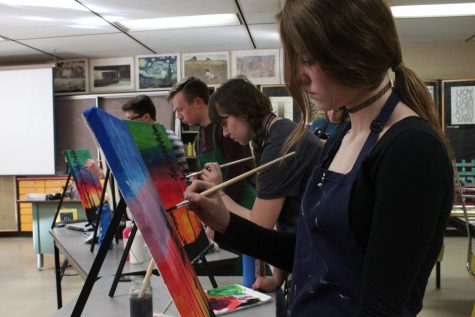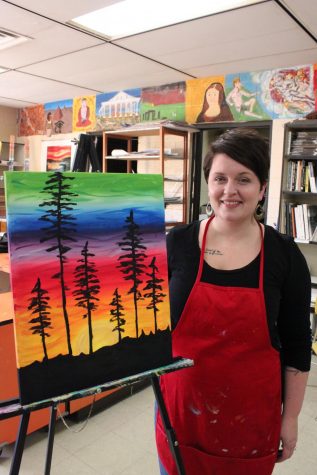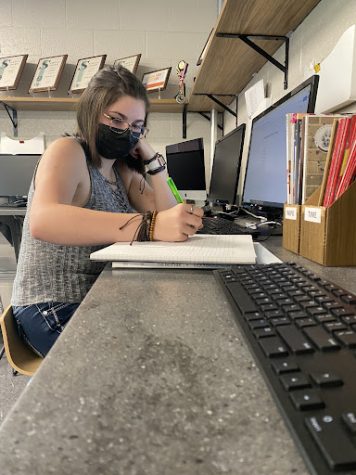Art Meditation
Emotional benefits of painting for meditation
Andrew Carriero begins to paint one of his trees for the background of his painting.
On March 7, eighth grader Rose Casto volunteered to participate in a painting session in the art room with five other curious students. Admitting that the painting session she participated in seemed tricky at first, Casto said, “Coming into it, I didn’t have much confidence. I knew I did have some skills from Art 1.” However, by the end she thought she gained more confidence and she obtained skills to practice acrylic painting.
Ever since creating art in elementary school, Elisha Penning, an art teacher and pastor from Kalamazoo, wanted to teach art to people, young or old. She decided in high school that she wanted that to be her career because art was her passion. Penning likes the way people engage in it whether it is through using hands or brushes to push feelings on a canvas.

Rose Castro intensively concentrates on painting her trees for the background of her sunset painting.
“It’s a pretty significant form of expression. It’s a way to get what’s going on inside of [students], outside of them,” Penning said. “I think the other importance of art is that it actually gives you an opportunity to maybe interact with other people as well.”
According to the Art Times, one of the steps to using art as meditation is the concept of the painter to be the painting. In meditation, paying attention to the object of focus, breathing and letting thoughts and feelings move up and through the person. One of the reasons it can be so important for people to be the painting is because of how the communication can speak through art.
Freshman Andrew Carriero thinks art is important to him in that way.
“It lets me express myself in different ways that I couldn’t normally do verbally,” he said. Carriero thought the painting session was a relaxed environment so, “he could express [himself] calmly without being judged.”
Art interpretation varies. Since each painting is different. It can give a range of emotions to viewers seeing the artwork and it can help depict the painter’s personality or feelings.
The Art Times also mentions another step of art meditation is to enjoy the time that is spent; to take account of feelings and creatively using what there is to slowly move to a more aware and positive space.
Senior Grace Schniers thinks she understands personalities and creativity in other people’s paintings.
“When I saw all those people [next to me] and the way they painted, it opened my mind up a little bit to the way they think… I can see it in their paintings.”
Steps to chilling out
Methods of relieving stress by painting
Achieving peace and relaxation through painting a simple picture is very effective and

Art teacher Elisha Penning proudly stands by her finished painting after teaching the six students to paint the picture of a colorful sunset with trees for the background.
easy.
According to Susan Squellati Florence and Patty Van Dyke, in noticing the colors, shapes, and textures, try to connect with the object of focus.
There is no judgement; just continue to breathe, letting thoughts and feelings move up and through. Accept your mistakes. Become surprised by them.
Keep the brush moving. Be the painting.
There is no one way to paint.
In meditation, it’s normal to lose track of time.
Brain waves change and it causes a shift in perspective.
Step back and look at the big picture. Sometimes when looking at what’s been painted from a distance, something will seem different; something new.
Each painting or meditation session slowly moves to a more aware and positive space.
From Art Times










